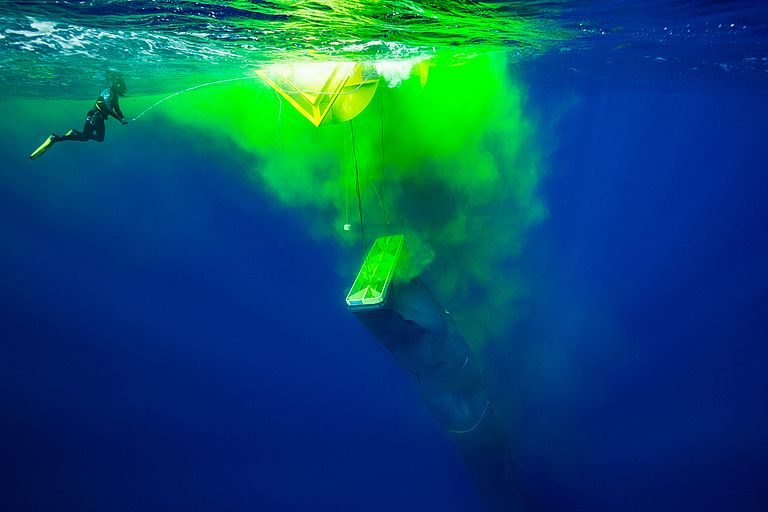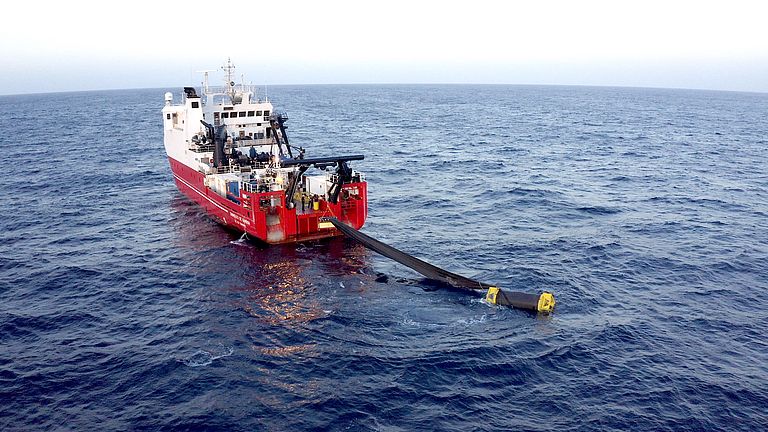Greening the ocean to combat climate change
Wave-driven upwelling pump deployed south of the Canary Islands
In the Paris Climate Agreement, the global community committed to limit global warming to well below 2° Celsius and to make efforts to keep it below 1.5° Celsius. This can only be achieved if, in addition to a drastic reduction in greenhouse gas emissions, we take measures to actively remove carbon dioxide (CO2) from the atmosphere.
Due to its large potential for carbon uptake, the ocean can play a major role in carbon dioxide removal (CDR). One marine CDR approach is to stimulate the biological carbon cycling, which is driven by growth of microscopic algae using the available nutrients to form biomass. In the process, CO2 is also absorbed and converted into organic material. Part of the algal biomass sinks directly to depth, part flows into the food web and reaches deeper water layers via the excretions of the animals. This process is limited by the availability of nutrients in the sunlit surface layer. In 50 percent of the world ocean, nutrients are in extreme short supply throughout the year and the biological carbon flux to depth is correspondingly sluggish. These regions, mainly in the tropics and subtropics, are often referred to as ocean deserts.
Artificial upwelling brings nutrient-rich deep water to the surface, thereby greening ocean deserts. The research network Test-ArtUp has now tested a wave-driven deep-water pump in the nutrient-poor subtropical Atlantic Ocean south of the Canary Islands. For the wave pump test, GEOMAR Helmholtz Centre for Ocean Research Kiel cooperates with the University of Las Palmas Gran Canaria and the U.S. company Ocean-based Climate Solutions Inc., which developed and built the wave-driven upwelling pump. The University of Las Palmas Gran Canaria coordinates the e-IMPACT project, which assesses the impact of oceanic eddies on the biological carbon cycling and leads an expedition on the Spanish research vessel Sarmiento de Gamboa to study an eddy south of the Canaries in an extensive measurement program. As part of this expedition, the wave pump was deployed inside an eddy and integrated into the measurement program. Researchers from GEOMAR carried out measurements to assess the dispersion of the upwelled water in the immediate vicinity of the wave pump from the sailboat Pandora V.
After surveying the oceanic eddy, a suitable position for the deployment of the wave pump was identified. "Important criteria for us here were sufficiently high nutrient concentrations at 200 meters water depth and a position that would ensure that the wave pump would remain in the eddy during the three weeks of its test run," explains Professor Dr. Ulf Riebesell, coordinator of the research network Test-ArtUp and head of the GEOMAR research team. After deploying the wave pump 140 nautical miles south of the Canary Island of El Hierro, the sinking bottom weight uncoiled the 200-meter-long pump hose from the drifting buoy and filled the 1.9-meter-wide hose. Fully deployed, the wave pump immediately began pumping deep water to the surface with each wave as the drift buoy rose and fell. "Flow meters installed in the pump indicated a pumping volume of 3000 cubic meters per hour. This was even 50 percent higher than predicted from wave height and period," explains Philip Kithil, managing director of Ocean-based Climate Solutions, who led the deployment of the wave pump aboard the Sarmiento de Gamboa.
To track the spreading of the upwelled deep water in the surface layer, GEOMAR divers introduced the environmentally harmless fluorescent dye uranine ten meters below the pump outlet the day after the release. Video recordings by the divers and measuring probes from aboard the sailing yacht Pandora V were used to track the outflowing water marked by the dye. To the surprise of the GEOMAR team, no pumping activity could be detected. Only later, data from a strain gauge on the pump revealed that the wave pump was already drifting through the water without its bottom weight at that time. The reason why the weight detached from the pump tube is currently unclear and will probably only be clarified when the wave pump is recovered by the Sarmiento de Gamboa at the end of the ongoing research expedition.
"Despite the early termination of the pumping activity, we learned a lot about the suitability of wave pumps for generating artificial upwelling," sums up Philip Kithil. Only after all the data has been evaluated can a final assessment be made of what new insights can be gained and what this means for further research in this area. "Whether artificial upwelling is a suitable CDR approach to enhance the oceanic uptake of carbon dioxide can only be decided with more information. This includes questions related to its environmental sustainability, scalability, economic viability, as well as regulatory considerations. The Test-ArtUp project is intended to provide the knowledge base for this," says Ulf Riebesell, summarizing the ongoing research. Whether this CDR approach will ever be used will ultimately have to be decided in a process involving all societal stakeholders.
Project funding and coordination:
Test-ArtUp is a research network within the mission Marine Carbon Storage as a Pathway to Decarbonization (CDRmare) of the Deutsche Allianz Meeresforschung (German Marine Research Alliance, DAM). It is funded by the German Federal Ministry of Education and Research and is coordinated at GEOMAR by Professor Dr. Ulf Riebesell.




